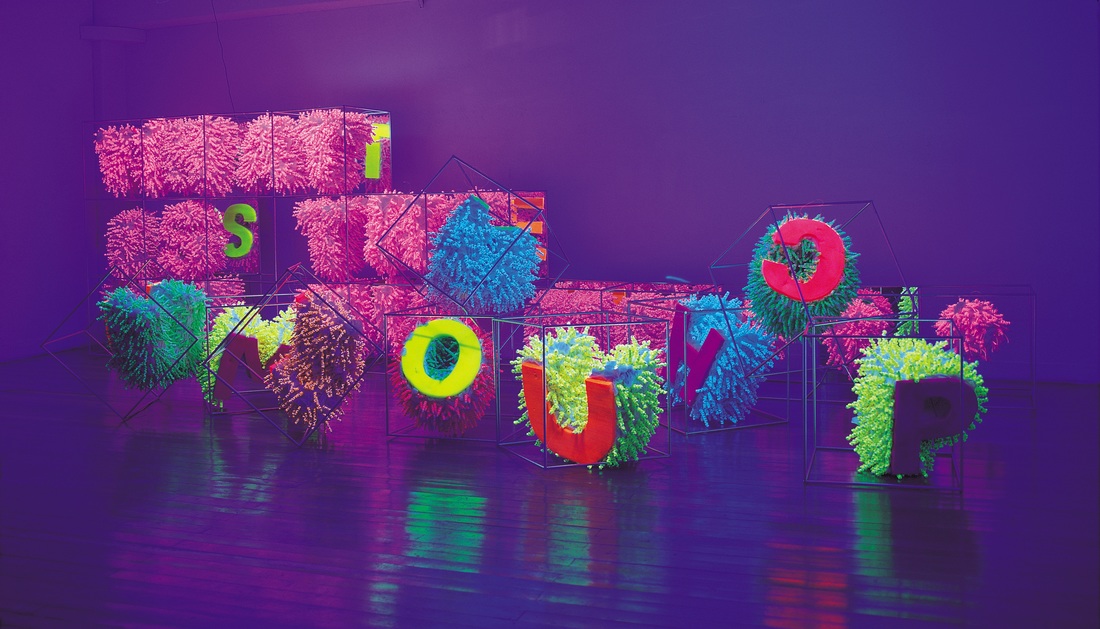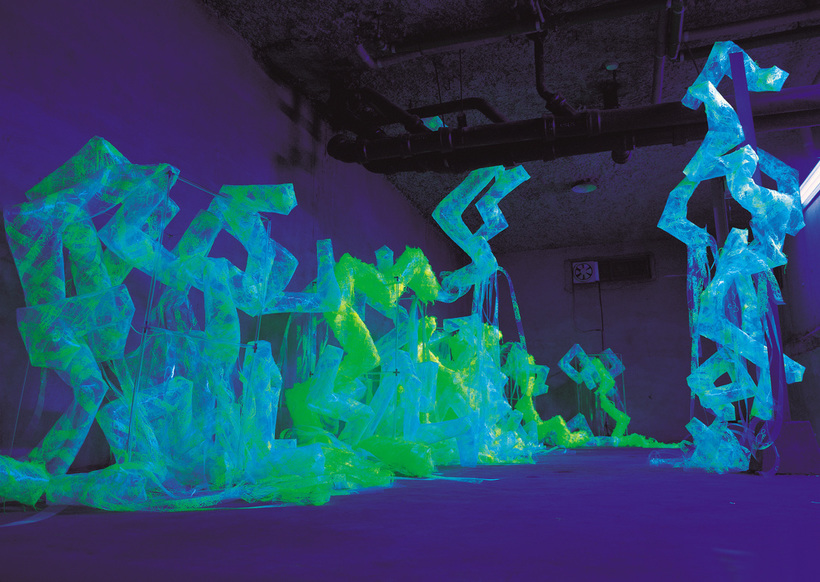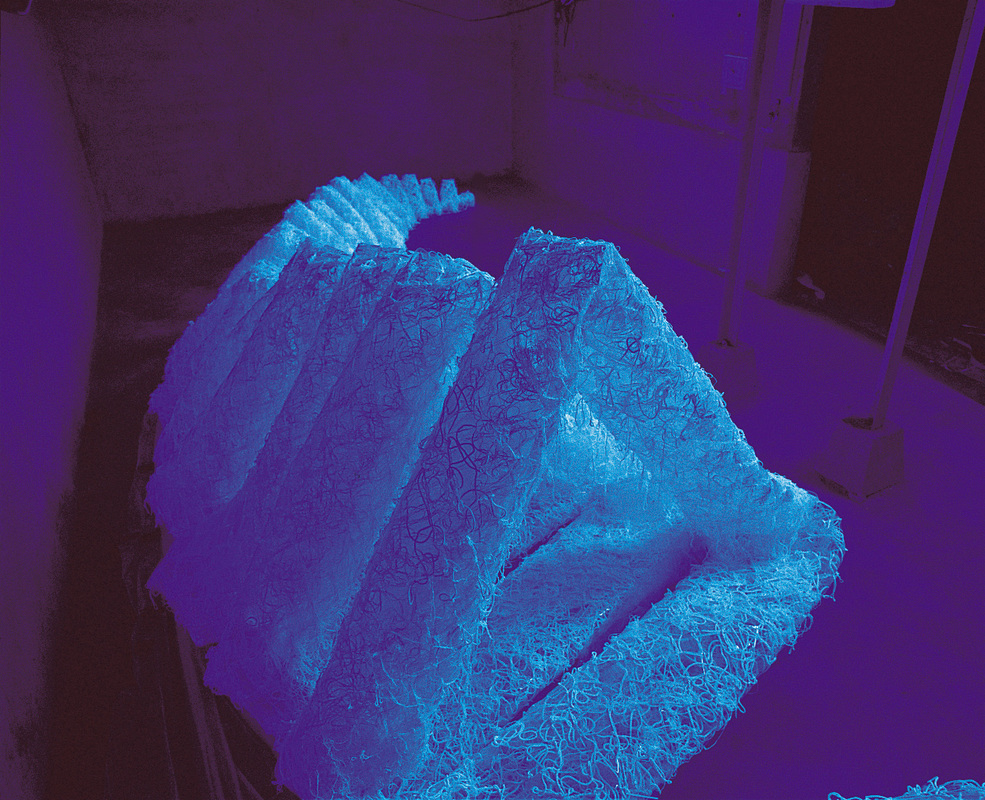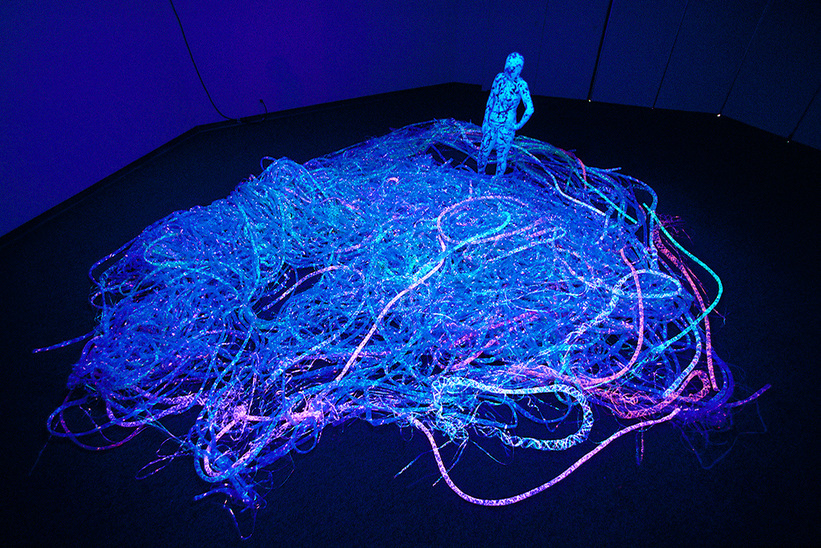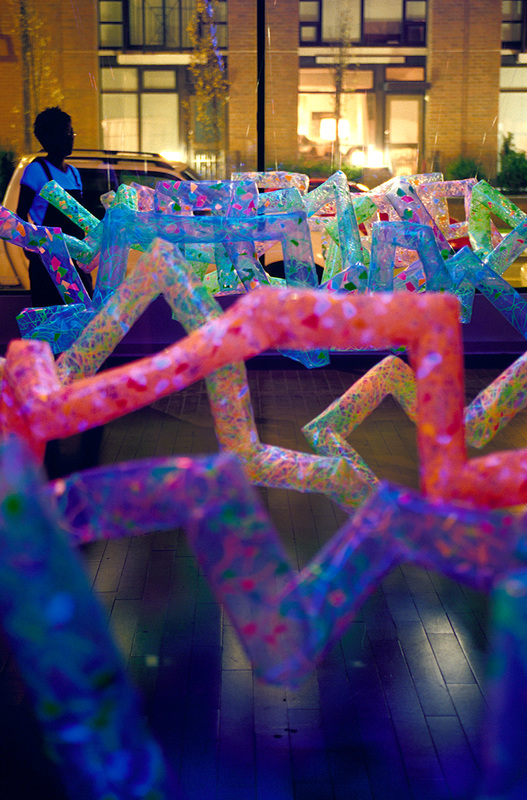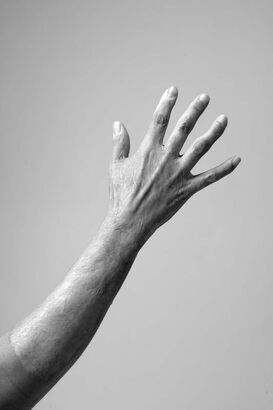
Time will tell. I was asked to do an exhibition in Berlin, Germany in the first group exhibition of artists from all over the world who use black lights, called Backlight Gallery in Berlin. As I was preparing for my exhibition there, I learned that the venue was at the very place of separation between East and West Germany. The exhibition place evoked the deep tacit family history, that of my father who had left his 4 children in North Korea during the mayhem of war. I have 4 step siblings who are still there to this day. I thought about all the other families with the similar pain and my next work was a house, a home, called ‘Living Together’.
I visited the site of Potsdam Conference which led to the separation of South and North Korea. I have installed New Potsdam Conference, to call for a new conference for unification. My family story is the story of many Koreans and so I have put the names of the 5000 families pained by this unsolicited separation in my work called Vanished Berlin Wall. Just wishing. Wishing.
In 2010, my father passed away without ever having heard of his children in the north. In my next exhibition, I made an installation at DMZ that included all the vowels and consonants of the names of separated families, to appease my father’s wounded soul.
I started looking deeper within. Hurt from the loved ones doesn’t always start with something as grandiose as war. It can start with a simple misunderstanding, but the pain is as real and as damaging, if not more. Although close in proximity, there are many families who are cut off from one another and so I installed ‘Chair of Understanding,’ a big chair and a bench in one of the busiest cities in Asia, Hong Kong.
To me, Yarn is the thread that connects what has been separated, for a more hopeful tomorrow.
I sincerely desire that my work with yarn may send a message of comfort, of understanding, and of peace.
I visited the site of Potsdam Conference which led to the separation of South and North Korea. I have installed New Potsdam Conference, to call for a new conference for unification. My family story is the story of many Koreans and so I have put the names of the 5000 families pained by this unsolicited separation in my work called Vanished Berlin Wall. Just wishing. Wishing.
In 2010, my father passed away without ever having heard of his children in the north. In my next exhibition, I made an installation at DMZ that included all the vowels and consonants of the names of separated families, to appease my father’s wounded soul.
I started looking deeper within. Hurt from the loved ones doesn’t always start with something as grandiose as war. It can start with a simple misunderstanding, but the pain is as real and as damaging, if not more. Although close in proximity, there are many families who are cut off from one another and so I installed ‘Chair of Understanding,’ a big chair and a bench in one of the busiest cities in Asia, Hong Kong.
To me, Yarn is the thread that connects what has been separated, for a more hopeful tomorrow.
I sincerely desire that my work with yarn may send a message of comfort, of understanding, and of peace.
Exhibitions & Criticism
Shaping of the Unknown and the Significance of the Insignificant
Jang, Kyung-Hwa - Gwangju Art Chief Curator, 2003
Fiber art owes its origin to the study of textiles. With the development of materials came the evolvement of diverse concepts, and since the 1960s many artists were found active in this sector. Today, fiber art is an integral part of modern art.
Lee, Eunsook began her study in the fiber arts during this time. While preparing for her first exhibition in 1986, she sustained a severe burn on her face and arm, undergoing eight operations with the possibility of permanently losing the use of her right hand. She recalls this period as one of the darkest yet most productive of years as this was the time she contemplated death. Her works reflect pain and growth from the challenges she had faced both personally and professionally.
Lee, Eunsook began her study in the fiber arts during this time. While preparing for her first exhibition in 1986, she sustained a severe burn on her face and arm, undergoing eight operations with the possibility of permanently losing the use of her right hand. She recalls this period as one of the darkest yet most productive of years as this was the time she contemplated death. Her works reflect pain and growth from the challenges she had faced both personally and professionally.
|
Lee's work first came to my attention in the 1990 exhibition, which marked a deviation from her earlier works. Her use of materials and the scale of her work progressed to incorporate the use of space. "What is the Mu Mu Mu.." was an experimental approach in fiber arts with its new technique in production, installation and use of light. She employed the traditional Asian variegation to create western alphabet, suggesting the meeting and clashing of two civilizations and the emanating of a new kind energy.
|
|
The "Waiting Soul" (1994) is a large-scale construction. Upon exhibition, this work transforms an anonymous space into a space of order and chaos in harmonious coexistence. The hand-woven construct of polyester films is reminiscent of a cave found in nature which stimulates our imagination. This exhibition successfully demonstrated her originality and her understanding of the material she chose to use. |
|
The "umbilical Cord" (1996) is an ensemble of cords hand-woven with strips of polyester films, neon threads and various fabrics, and is accompanied by the sound of heartbeat. The cords can only be viewed indoors with fluorescent lighting, and are arranged on the floor for viewers to freely interact with. Unlike what the name may suggest, the cords emit an aura of mystery along with lively energy. With the sound of fetal heartbeat, the symbolic womb generates an urge to explore the sublime within one's subconscious.
Lee's project is a culmination of repeated manual labor through which she shapes the unknown world; it is a meditation of life and death, anda quest for what lies beyond.
She uses tangible shapes, such as the alphabets and the numbers, to convey messages from the subconscious to a world in which value is measured by numbers. Furthermore, she questions the significance of worldly accomplishments from the perspective of what lies beyond-directing our attention to examine their insignificance. Lee's recent works integrate the use of neon fabrics, lighting and acoustic, the tools by which she communicates with her inner self. Her unrestrained creativity enhances the language of expression, enabling her to articulate her concerns in her work. She is a prolific artist in whom I expect continued growth and development |
Dematerialized Fantasy Space
Park, Rea-Kyung - Art Critic, 1994
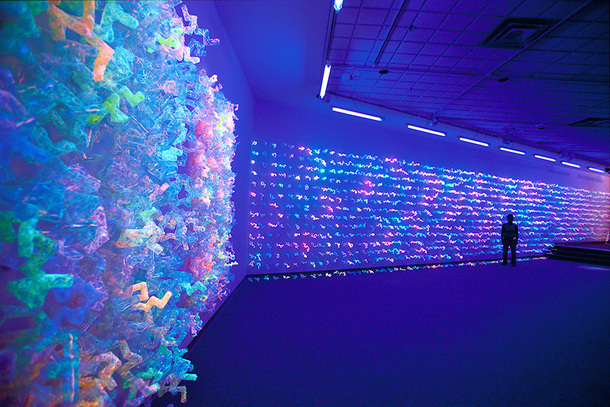
.
Eunsook Lee's work is a process of interpreting her world in her own terms by creating order from disorder. Her works conjure up a fantasy by adding the fluorescent material to the main subject of fabric such as cotton thread and play into the needs of people who are entangled in the modern complexity and long for an escape. Twisting, unthreading and hanging loose things and cords, are the typical of hand work of weaving the artist's mind into a story.
Recently some people adopt a variety of mass-produced fabric materials as their main subject and weave or hang them by hand. Lee's work is also part of this trend.
There might be some difference in the degree and the scale, but people are often infatuated by this kind of hand work largely because dynamic and rhythmic entwining and hanging of thread and hempen brings life to the non-lively materials.
Lee has tried many approaches to her object. Her latest one, though , is to unthread coloured cotton thread or white cord on a skein of thread and plaster them on the polyester film and then weave this newly created material into thin or thick strings. This seemingly boring and aimless work of putting the unending threads onto the film, cutting it into new fabric cords and weaving and twisting them creates a totally new formative art. This is exactly what Lee does nowadays. She is fascinated with fashioning a dematerialized fantasy world by affording order to the chaotic threads in her hands. She also indulges herself in amplifying the fantasy effect with lighting project on the transparent polyester film entwined with fluorescent color threads. This shows her innocent imaginary world that is the reminder of virgin woods and caves of the timeless myth or fairy tales.
Eunsook Lee's work is a process of interpreting her world in her own terms by creating order from disorder. Her works conjure up a fantasy by adding the fluorescent material to the main subject of fabric such as cotton thread and play into the needs of people who are entangled in the modern complexity and long for an escape. Twisting, unthreading and hanging loose things and cords, are the typical of hand work of weaving the artist's mind into a story.
Recently some people adopt a variety of mass-produced fabric materials as their main subject and weave or hang them by hand. Lee's work is also part of this trend.
There might be some difference in the degree and the scale, but people are often infatuated by this kind of hand work largely because dynamic and rhythmic entwining and hanging of thread and hempen brings life to the non-lively materials.
Lee has tried many approaches to her object. Her latest one, though , is to unthread coloured cotton thread or white cord on a skein of thread and plaster them on the polyester film and then weave this newly created material into thin or thick strings. This seemingly boring and aimless work of putting the unending threads onto the film, cutting it into new fabric cords and weaving and twisting them creates a totally new formative art. This is exactly what Lee does nowadays. She is fascinated with fashioning a dematerialized fantasy world by affording order to the chaotic threads in her hands. She also indulges herself in amplifying the fantasy effect with lighting project on the transparent polyester film entwined with fluorescent color threads. This shows her innocent imaginary world that is the reminder of virgin woods and caves of the timeless myth or fairy tales.
In the Light of Healing
Lee, Julie Jung-sil - Art Critics, 2013
As an installation artist, Eunsook Lee grafted commemorative narratives of wartime soldiers and victims onto a challenging and sensory, contemporary art form. Motivated by the tragedies of her own family history—her father left his family in North Korea and later passed away without ever having a chance to reunite with them—Lee has sought to engage in the collective and personal sense of wartime trauma. Sad wartime stories continue to be handed down by communities of survivors, firsthand witnesses, and subsequent generations. As a reminder of the sorrow of separated families, she exhibited her light art, Vanished Berlin Wall in Berlin and Separated Names at the DMZ in Korea. Now, she installs a message of peace in Washington, D.C. to promote the dignity of life and these stories’ continuation and connection in our memories.
Lee’s work aims to inspire the audience, especially future generations, and to create empathy with the pain of wartime victims. She hopes to reunify separated families not only in North and South Korea, but also those displaced by conflicts around the world. In her search for healing of her own personal trauma—afflicted by her family situation and by an injury while creating her works—she collected photographs of wartime victims, including women who were once kidnapped or trafficked into sexual slavery yet whose souls survived with dignity. They radiate like bright stars in her works.
Lee suggests artistic healing through overlapping fragments of history. Her artistic tools include polyester, archived photographs, fluorescent threads, and black lighting. Umbilical Cords is an exceptional installation made of hand-woven cords, strips of polyester film, neon threads, and black lights accompanied by the sound of a heartbeat. Lee’s projects require painstaking manual fabrication and the collaboration of other hands, a process in which the artist and participants can meditate and better grasp the meaning of life and the importance of connections among people.
